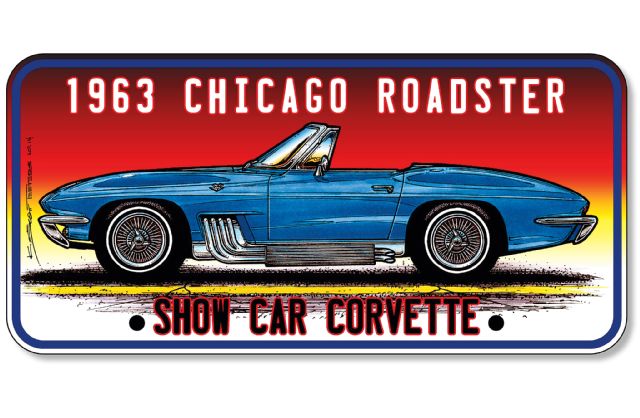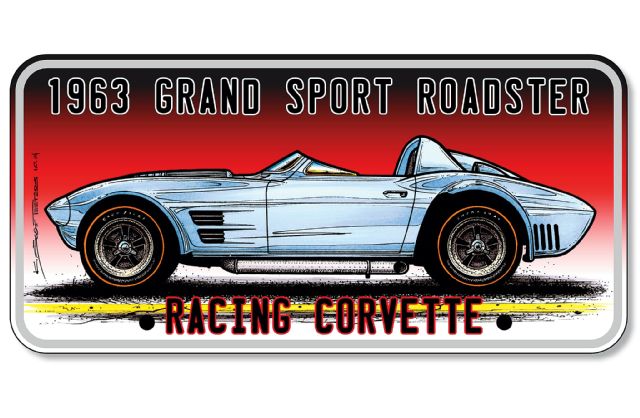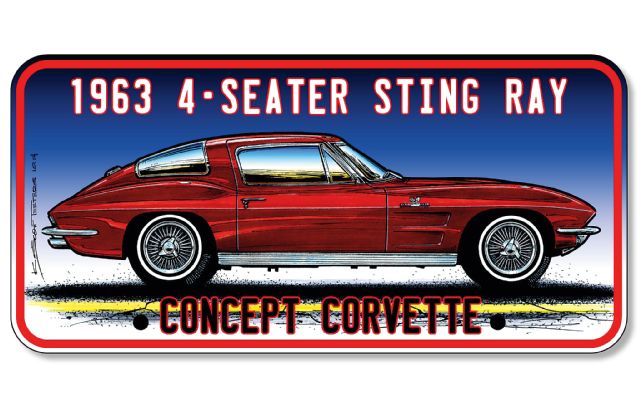A look back at Chevrolet’s experimental, prototype, concept car, and show car Corvettes.
Words and Art by Scott Teeters as republished from Vette Magazine’s SuperChevy.com. Read the other experimental stories HERE.
General Motors makes hundreds of kinds of cars and trucks. Some sell hundreds of thousands of units a year, which makes Chevrolet’s Corvette a complete enigma. Given the small number of Corvettes sold every year, it is a modern American manufacturing miracle that the car survived for 61 years.
The Corvette was “officially” born on January 17, 1953 at the GM Motorama Show at the Waldorf Astoria Hotel, in New York. To understand the impact of Harley Earl’s two-seater sports car concept car, you have to look at typical cars of 1953. The car was low and sleek, and wasn’t over festooned with styling gimmicks. Based on the response from attendees, Chevrolet rushed the car into production, and the rest is history.
Today, the Corvette is GM’s flagship car. When Chevrolet unleashes a new Corvette, the automotive world stops to take notice. But things were not always this way. Up to the C4, there were many inside GM that wanted to see the Corvette go away. For the first 20-some years, the car suffered from an identity crisis. Inside GM there were always those that wanted the Corvette to be something different; a lightweight sports car, a mid-engine car, a rear-engine car, a four-seater personal luxury car, powered by a boxer-type flat-six, Wankel rotary-powered, turbocharged small-displacement hemi-headed double-overhead cam powered, and even an all-aluminum car. Chevrolet kept the loyal faithful stoked with two or three experimental, prototype, show car Corvettes per year. From an enthusiast’s perspective, this was endlessly fascinating.
This is part five of a chronological look back at Chevrolet’s high-profile experimental, prototype, concept car, and show car Corvettes. Some of the cars had exotic names such as, “Astro-I,” “Astrovette” and “Geneve.” Others had experimental prototype numbers, such as “XP-700” and “XP-882.” And some had sexy names, such as, “Nomad,” “Mulsanne,” “Snake Skinner,” “Mako Shark,“ and “Tiger Shark.” In retrospect, a few of the cars were the shape of things to come, but most were simply, “Here’s an idea of something we’re working on.” Either way, it was all a ton of fun!
1963 Corvette Roadster Show Car

Harley Earl is a legend in the world of automotive design. As a young man, Earl worked in his father’s coachbuilding business in Hollywood, designing and building custom cars for film stars. In 1927, Earl was commissioned to design an all-new LaSalle for Cadillac. The design was so stunning that GM’s president, Alfred P. Sloan, hired him to run the new Art and Color Department at GM. Prior to this, Detroit cars were designed to be functional, Earl gave them, “Style!”
Earl was a large, imposing man with true vision. His ’39 two-seater Buick Y-Job is considered the first “Concept Car.” Then in 1949, he launched the GM Motorama. From 1949 to 1961 this was GM’s extravaganza to show concept cars and this is where the Corvette made its debut. By 1953, Earl was five years away from retirement and his successor was already handpicked.
Bill Mitchell was hired by Earl in 1935 and rapidly rose through the ranks. By 1954 Mitchell was Director of Styling, just below Earl. Mitchell loved cars and used to say, “I’ve got gasoline in my veins!” He especially loved Earl’s Corvette. When Earl retired in 1958 and Mitchell took the reins, he was ready to restyle the Corvette into “his” Corvette.
Like Earl, Mitchell could be tough and intimidating. Earl liked rounded, heavy designs with lots of chrome. Mitchell liked designs with sharp creases, like a freshly pressed suit, and minimal chrome. That’s what made the new Sting Ray so outstanding. Starting with the Q-Corvette concept, designed by Peter Brock and Bob Veryzer, Mitchell guided designer Larry Shinoda to rebody the ’57 Corvette SS Racer into Mitchell’s ’59 Stingray Racer. The car was so hot looking, it just had to be the next Corvette. With Mitchell’s oversight, Shinoda and his team turned the Stingray Racer’s shape into a production automobile. When the all-new Sting Ray was debuted in the fall of 1962 it looked like the future had arrived in a space ship!
To stoke the fans and the press, a special ’63 Sting Ray Roadster was built for the 1963 Chicago Auto Show. Actually, two cars were built, with the second one finished at a later date and gifted to Mitchell’s old boss, Harley Earl. Mitchell loved side-exhausts, so the first thing you notice is the four header pipes exiting from the front fenders, sweeping down and collecting into a finned muffler. Knock-off aluminum wheels provided the perfect amount of bling. The car was painted light pearlescent blue with a white stripe that began at the tip of the spear on the nose that ran back to the lower rear valance. Other special details included chrome trim, body emblems, interior control knobs, and four-wheel disc brakes (a feature that showed up on the ’65 Corvette). Under the hood was a stock 360hp fuelie backed up with a four-speed transmission. The interior was trimmed in blue with white seat inserts.
Harley Earl’s Corvette was, except for a few details, identical. Earl lived in West Palm Beach, Florida, so it was determined that because of the need for air conditioning, the 300hp 327 engine would be better suited for Earl’s daily driver. The interior of Earl’s car had special machined aluminum floor mat inserts. But most notable was the glovebox door, festooned with an inside/outside thermometer, vacuum gauge, accelerometer, and altimeter.
Earl enjoyed the car for a few years and eventually sold it, thus beginning it’s road to near obscurity. Eventually, it surfaced at the Corvettes at Carlisle Show in 1980 when Joe Clark recognized that there was “something special” about the car and bought it the following year. Later, the car was given a full restoration with help from the GM Design staff. Then in 2010, the car sold at the Mecum Auction for $925,000 and then sold again in 2013 at the Barrett-Jackson Auction for $1.5 Million.
A piece of Corvette history was saved from the junkyard, but whatever became of the Chicago Show version?
1963 Grand Sport Corvette Roadster

The Grand Sport was Duntov’s grand vision of what the Corvette should be. Zora wanted to build 125 Grand Sports, then another 1,000 to be sold through Chevrolet dealerships. The design was more than capable for a racing car in 1962. What Zora didn’t know was that his initial batch of five Grand Sports would be the onlyGrand Sports built.
The cars had two obstacles—one political and one mechanical. GM still followed the “we don’t race” policy that started with the 1957 AMA ban on manufacturers participating in racing. Auto racing back then was seriously dangerous with lots of drivers being killed in horrific wrecks. GM simply didn’t want the bad publicity. The second obstacle was a lack of development time, combined with little understanding of race car aerodynamics. The Grand Sport program didn’t have a snowball’s chance.
The hammer came down fast the first week of January 1963. When news of the Grand Sport’s December testing at Sebring reached GM Chairman Frederick Donner’s desk, the Grand Sport was dead. It’s amazing that the cars weren’t ordered to the crusher. For the rest of 1963 all that Duntov could do was loan the cars out to privateers. While capable as racers, they didn’t have the means to seriously develop the cars. So, the Grand Sports basically starved from a lack of nurturing.
About the aerodynamics. From the beginning, the new ’63 Corvette suffered from front-end lift at high speed. As aerodynamic as the design looked, there was far too much air flowing under the car. Combined with the new independent rear suspension’s tendency to squat upon acceleration, it was the perfect combo for a wild, high-speed ride—frightening was more like it. Beyond streamlining and reducing a car’s frontal area for less wind resistance, aerodynamics was not well understood in the early ’60s.
After the ’63 racing season, three of the five Grand Sports were brought in for “improvements” as part of a covert plan to just once, stick it to the Shelby Cobras. The Nassau Invasion at the end of November and early December 1963 was the Grand Sport’s finest hour. The two remaining Grand Sports that weren’t raced at Nassau got some extra-special treatment. Working with the “reduced frontal area” aerodynamic model, the two remaining cars were converted into roadsters, in addition to the “improvements” the coupes received for the Nassau effort. The cars looked mean as hell, but were held back because Chevrolet general manager Semon Knudsen received a serious dressing down that nearly cost him his annual bonus. So the roadsters were put into storage.
In 1965, Grand Sport Roadster #002 was used as a Chevrolet show car at Notre Dame University. The automotive press said that the Grand Sport Roadster would make an interesting race car if equipped with the new 427 NASCAR engine. Roger Penske liked the idea and made arrangements to buy Grand Sport Roadster #001 as part of his two-car team for the 1966 Sebring race. The second Penske car was a prototype L88 ’66 Corvette coupe. Even though Penske’s Grand Sport was equipped with a large front spoiler, the back end squat and the extra grunt from the torque-monster L88 made the front-end lift worse.
Penske’s team did an admirable job preparing the cars, but the lack of development of the now four-year-old racer was its ultimate undoing. Roadster #001 only completed 65 laps at the 1966 Sebring race. Later that spring, George Wintersteen bought Roadster #002 through his friend Roger Penske and raced the car through the ’66 season. No wins were recorded.
Aside from the impressive 1963 Nassau race, the Grand Sports were not successful race cars. Timing is everything and the Grand Sport’s timing was all wrong. However, the happy ending is that all five cars are accounted for. The Wintersteen #002 Grand Sport is owned by Dr. Fred Simeone and participates in The Simeone Museum’s monthly Demonstration Day events.
1963 Four-Seater Corvette

Part 1, Part 2, Part 3, Part 4
